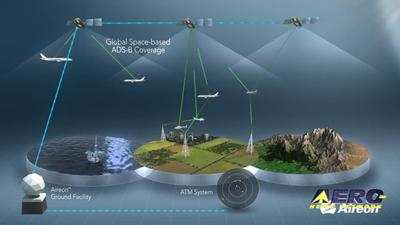School Of Aeronautics And Astronautics Finds Significant CO2 Reductions Are Possible
A new report, based on research from Purdue University's School of Aeronautics and Astronautics, analyzes the potential impact of space-based ADS-B technology on global aviation carbon emissions in remote and oceanic airspace. Authored by Dr. Karen Marais, the report titled Environmental Benefits of Space-based ADS-B, indicates that the implementation of this technology can offer benefits preventing approximately 14.3 million metric tons of carbon dioxide (CO2) from being released into the atmosphere between 2020 and 2030. This is equivalent to removing more than 300,000 cars from U.S. roads each of those years, while making no changes to aircraft design or fuel.

According to 2015 estimates from the International Civil Aviation Organization (ICAO), commercial aviation contributes about 2 percent of global manmade CO2 emissions annually. Significant contributors to this are oceanic and remote airspace routes, which lack radar coverage and operate under separate procedures as compared to radar-controlled airspace. That difference comes with a heavy emissions penalty. Due to lack of real-time surveillance in those regions, air traffic control separates aircraft "procedurally" by approximately 50 nautical miles.
While procedural airspace helps manage safety-risk, it can also be inefficient. Marais found that space-based ADS-B offers a near-term solution for the aviation industry to limit fuel emissions by improving operations and efficiencies in remote and oceanic airspace. It accomplishes this by using more precise locating capabilities and enabling optimum altitudes, speeds and routes.
"When tackling the issue of emissions in aviation, the industry has three options. Designing and building more efficient engines and airframes, developing sustainable alternative fuels and flying aircraft more efficiently from point A to point B," says Marais. "The only one of these poised to make a near-term, most immediate impact is to fly aircraft more efficiently, and to do so, new technologies like space-based ADS-B are imperative. This technology offers both immediate cost savings to airlines and long term environmental benefits to society--a win-win combination."

Further, significant benefits exist for airlines outside of reduced emissions. The report cites a 2016 analysis from NAV CANADA pertaining to a major U.S. carrier indicating that, better routing, access to higher altitudes as fuel is burned and variable airspeed can result in an annual savings of approximately $18.25 million, or $475 per flight.
The report concludes that space-based ADS-B has the capability to, "…proactively contribute to reducing aviation's contribution to climate change today and meet current and future CO2 reduction commitments and international agreements being considered by agencies such as the U.S. EPA (Environmental Protection Agency) and the U.N. ICAO." This includes initiatives like the Carbon Offset and Reduction Scheme for International Aviation (CORSIA), established by ICAO this past Fall to reduce aviation emissions. It also supports the White House goal to reduce the United States emissions below 2005 levels, a reduction of 26 to 28 percent.
Aireon's space-based ADS-B service is expected to be operational in 2018, shortly after the completion of the Iridium NEXT satellite constellation. The constellation will consist of 66 operational low-earth-orbit satellites providing 100 percent global coverage. The service will also provide Air Navigation Service Providers (ANSPs) with global aircraft surveillance capability, and is expected to help reduce fuel costs, increase safety and enable more efficient flight paths.
(Source: Aireon news release)
 ANN's Daily Aero-Term (04.26.24): DETRESFA (Distress Phrase)
ANN's Daily Aero-Term (04.26.24): DETRESFA (Distress Phrase) ANN's Daily Aero-Linx (04.26.24)
ANN's Daily Aero-Linx (04.26.24) Airborne 04.22.24: Rotor X Worsens, Airport Fees 4 FNB?, USMC Drone Pilot
Airborne 04.22.24: Rotor X Worsens, Airport Fees 4 FNB?, USMC Drone Pilot Airborne 04.24.24: INTEGRAL E, Elixir USA, M700 RVSM
Airborne 04.24.24: INTEGRAL E, Elixir USA, M700 RVSM Airborne-NextGen 04.23.24: UAVOS UVH 170, magni650 Engine, World eVTOL Directory
Airborne-NextGen 04.23.24: UAVOS UVH 170, magni650 Engine, World eVTOL Directory



